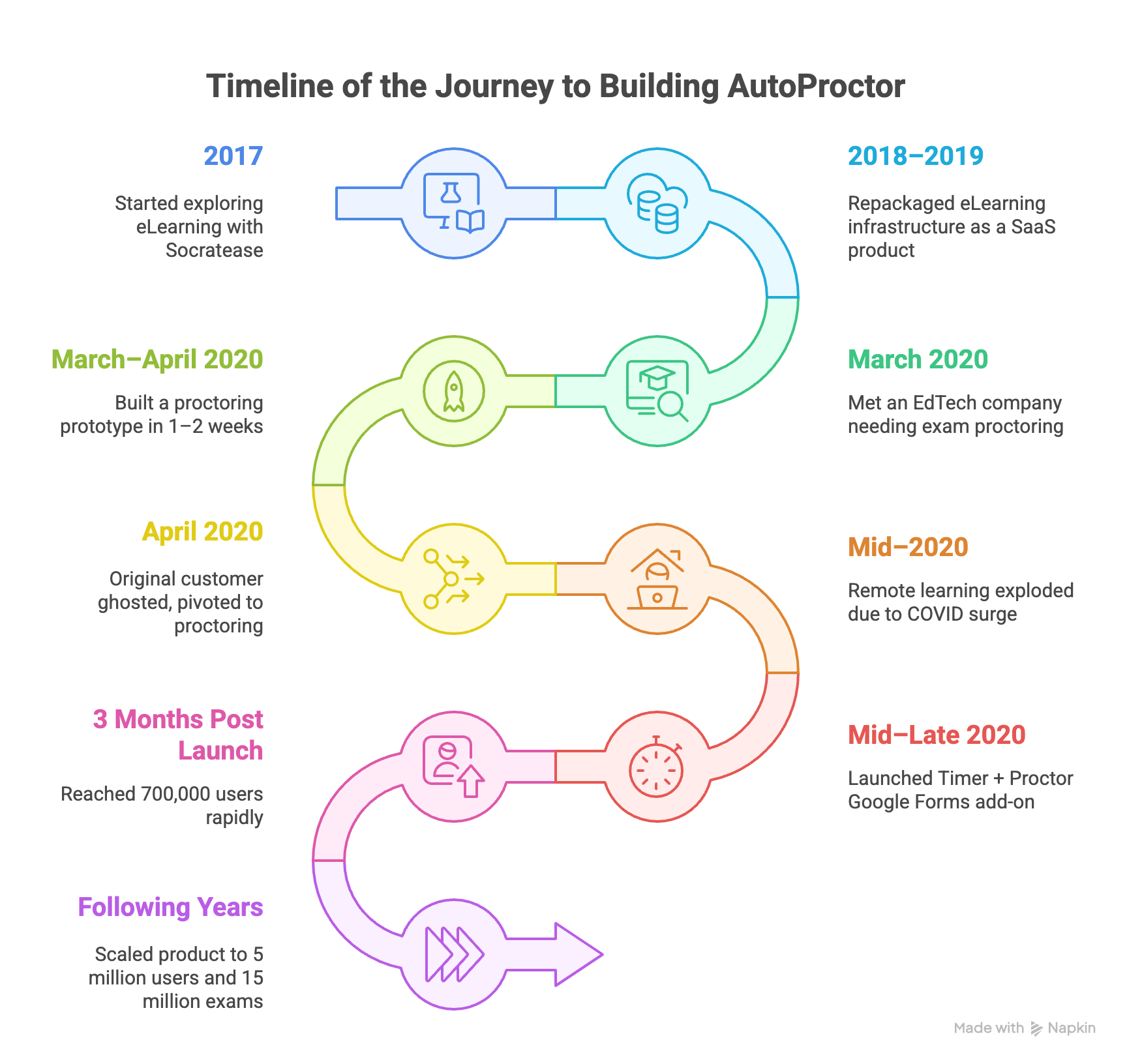How AutoProctor came to be

I am often asked how I, someone with a background in Academia, ended up building a proctoring tool. This is the backstory.
I have been dabbling in eLearning since 2017. I started Socratease, initially to explain Science-related topics in an interactive manner. When that didn't succeed as a business, I moved on to creating content for high-school Science students and tried to to sell it to schools. This was an even worse business outcome. But I had spent a lot of time creating the infra for eLearning content. So, I decided to sell this as SaaS (Shopify for eLearning) and thankfully found a few paying customers. Though the overall business outcomes weren't great in these years, I learnt a lot about web development and user experience.

In March 2020, I met a prospective EdTech customer that conducted their exams online. They wanted to ensure that their candidates didn't cheat on the exam. Because thousands of candidates attempted the exam, they couldn't have a human on a video call. Their existing "automated" proctoring tool basically took a photo of the candidate's camera feed every 10 seconds or so. This meant, someone would have to review hundreds of photos from each candidate. They wanted to automate this aspect of reviewing the camera footage. Funnily enough, just a couple of months prior, I had seen a blogpost that talked about using eyeball movement to play PacMan (maybe this?). TensorFlow JS (a Machine Learning Package) had been released and one could easily build a web game where if you moved your eyelids to your right, PacMan would move to the right. Out of curiosity, I re-built the same thing, using code provided on the blogpost, and was amazed it worked. I figured that if Facial Detection had become so advanced that it could track eyeball movement, it could surely track whether a face was there on screen. So, I set about building for the proctoring use-case, using the same technology.
I spent a week or so and built a prototype that demonstrated it worked. I could reliably detect if people were looking at the screen. I spent another week or so and could now detect if there was noise in the environment, and record it. So, if there were audio cues being shared, that got tracked. The easiest way to cheat, of course, is to open a different website. I built something for that too. So, you could see screenshots of your Google searches. And then I wrote a simple interpolation formula (which we of course have been referring to as our proprietary algorithm 😉) that took in all these violations and calculated a Trust Score. Further, as I built out the system, I took a lot of technical decisions that helped the service handle thousands of concurrent candidates with very few resources needed. For the first few months of launch, the entire AutoProctor service was running on a single $5 DigitalOcean droplet, and had conducted at least a million exams!
Anyway, I had cracked it! I had built a brilliant system for proctoring. The customer must have been delighted with what I had done, right? Wrong! I got ghosted by them! Within a month of meeting them, I had built something far more effective than what they were using and was offering it to them at 1/10th the cost. I built it specifically for them. In fact, I had even had a written agreement with them that if what I build works, they'd switch over to my product. This was because I was building proctoring as a feature for them so that they switch over to my eLearning platform. I was still focused on eLearning, and the proctoring tool was the hook. Despite all this, no response from them. I hate following up with people for these sorts of things and so after a couple of follow-ups, I gave up on them. I don't think they were malicious in their intent, they just didn't care about this problem enough.
This is the story of thousands of young entrepreneurs, I guess. You are a nobody and nobody will take you seriously. In my case though, I got very lucky. Just around this time is when COVID went on a rampage. Schools were shut and everyone switched to remote learning. So, suddenly, what I had built became extremely relevant. But, I had just built a technology. I still had to figure out how to (i) get people to discover this; (ii) integrate this technology with their workflows.
For this, I got extremely valuable (and, in my case, life-changing) advice from a fellow founder, Chetan Agarwal. Chetan had been running his eLearning startup Magogenie and we had spoken a few times on the phone. When we were discussing this, he suggested that I launch it as an add-on to Google Forms. I didn't know this at the time, and most of you may not either, but just like Apple and Android have their App Stores, Google Workspace products like Docs, Sheets, etc have their own app store. When I saw the app store for Forms, I saw that apps that just enabled a Timer for Google Forms Quizzes had millions of installs!
This insight from Chetan helped me package AutoProctor. The app store solved (i) above. I built the add-on in such a way that in just 1 click, you were able to convert your Google Form Quiz into a proctored exam. You could customize the proctoring settings significantly. This solved (ii) above. Because most people were looking for a timer, I even launched a timer feature and called it Timer + Proctor (it is still called that today!). People came looking for a timer, saw the proctoring feature and used it. In 3 months of launching the add-on, we hit 700,000 users. We got into YCombinator with that product. I then hired a few developers and scaled the product out to 5 millions users and 15 million exams over the course of a few years.There is a lot more I want to say, about how we scaled the product and what my learnings from all this are. Maybe I will do so in the future.


